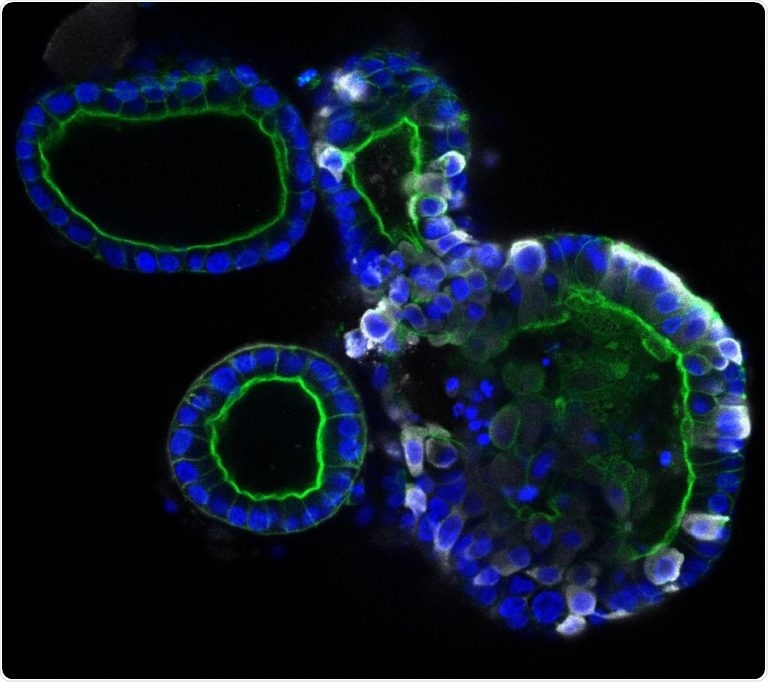Scientists from the Hubrecht Institute in Utrecht, Erasmus MC University Medical Center Rotterdam, and Maastricht University in the Netherlands have identified that the coronavirus SARS-CoV-2, known to cause COVID-19, infects intestinal cells and undergo proliferation there.

Intestinal organoids, the right one infected with coronavirus SARS-CoV-2. The coronavirus is colored white, the organoids themselves are colored blue and green. Image Credit: Joep Beumer, copyright Hubrecht Institute.
They have successfully distributed the virus in vitro and observed the cells’ response to the virus using advanced cell culture models of the human intestine. Thus, they have developed a new cell culture model to study COVID-19.
The study outcomes can help explain the observation that around one-third of COVID-19 patients suffer from gastrointestinal symptoms like diarrhea and that the virus can be detected in stool samples. The findings were published in the Science journal on May 1st, 2020.
Patients suffering from COVID-19 present with a range of symptoms linked to respiratory organs—like sneezing, coughing, fever, and shortness of breath. The transmission of the disease occurs through tiny droplets, which spread mainly through sneezing and coughing.
However, one-third of the patients also present with gastrointestinal symptoms like nausea and diarrhea. Besides, the virus can be detected in human stool even long after the respiratory symptoms disappear. This indicates that the virus can also spread through fecal-oral transmission.
The gastrointestinal and respiratory organs might appear very different but they have some key similarities. The presence of receptor ACE2, through which the COVID-19 causing SARS-CoV-2 virus can penetrate the cells, is a specifically intriguing similarity.
The intestines’ interior is packed with ACE2 receptors. But to date, it is not clear if the intestinal cells could be infected and produce virus particles.
Intestinal organoids
Researchers from the Hubrecht Institute, Erasmus MC, and Maastricht University intended to find whether the SARS-CoV-2 virus infects the cells of the intestine directly and if it happens so, whether it can undergo replication there.
The researchers made use of human intestinal organoids, which are smaller versions of the human intestine that can be cultivated in the laboratory.
These organoids contain the cells of the human intestinal lining, making them a compelling model to investigate infection by SARS-CoV-2.”
Hans Clevers, Hubrecht Institute
Infection of intestinal cells
Upon adding the viruses to organoids, the researchers found that they got infected quickly. The virus penetrates a subset of the cells in the intestinal organoids, and there is an increase in the number of cells infected over time.
The researchers identified virus particles within and outside the cells of the organoids using electron microscopy, which is an advanced technique for detailed visualization of various components of the cell.
Due to the lockdown, we all studied virtual slides of the infected organoids remotely from home.”
Peter Peters, Maastricht University
The researchers used a technique called RNA sequencing, a method for investigating which genes are active in the cells, to investigate the response of the intestinal cells to the virus. It was found that the interferon-stimulated genes got activated.
These genes are known to fight against viral infection. The focus of future studies will be on these genes and the way they can be used to develop novel treatments.
The researchers cultivated organoids under various conditions that resulted in cells with lower and higher levels of the ACE2 receptor, through which SARS-CoV-2 can penetrate the cells. The surprising fact was that the virus-infected cells with both lower and higher levels of the ACE2 receptor.
These research works could eventually pave the way for new ways of inhibiting the entry of the virus into human cells.
Implications
The observations made in this study provide definite proof that SARS-CoV-2 can multiply in cells of the gastrointestinal tract. However, we don’t yet know whether SARS-CoV-2, present in the intestines of COVID-19 patients, plays a significant role in transmission. Our findings indicate that we should look into this possibility more closely.”
Bart Haagmans, Erasmus MC
This study is in accordance with other recent studies that found gastrointestinal symptoms in a larger cohort of COVID-19 patients, as well as a virus in the stool of patients who did not present with respiratory symptoms.
Specialized attention is required for those patients with gastrointestinal symptoms. Thus, extensive testing using nose and throat swabs along with rectal swabs or stool samples may be required.
Meanwhile, the researchers will continue to collaborate to study more about COVID-19. They have been analyzing the differences between infections in the lung and the intestine by a comparison of the lung and intestinal organoids infected with SARS-CoV-2.
Source:
Journal reference:
Lamers, M. M., et al. (2020) SARS-CoV-2 productively infects human gut enterocytes. Science. doi.org/10.1126/science.abc1669.